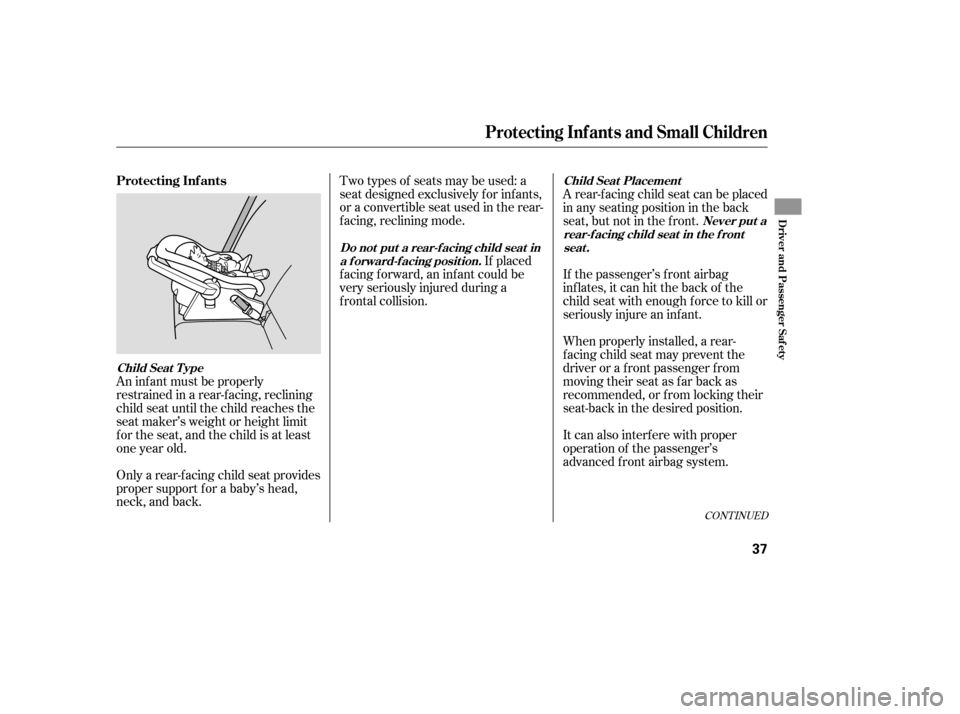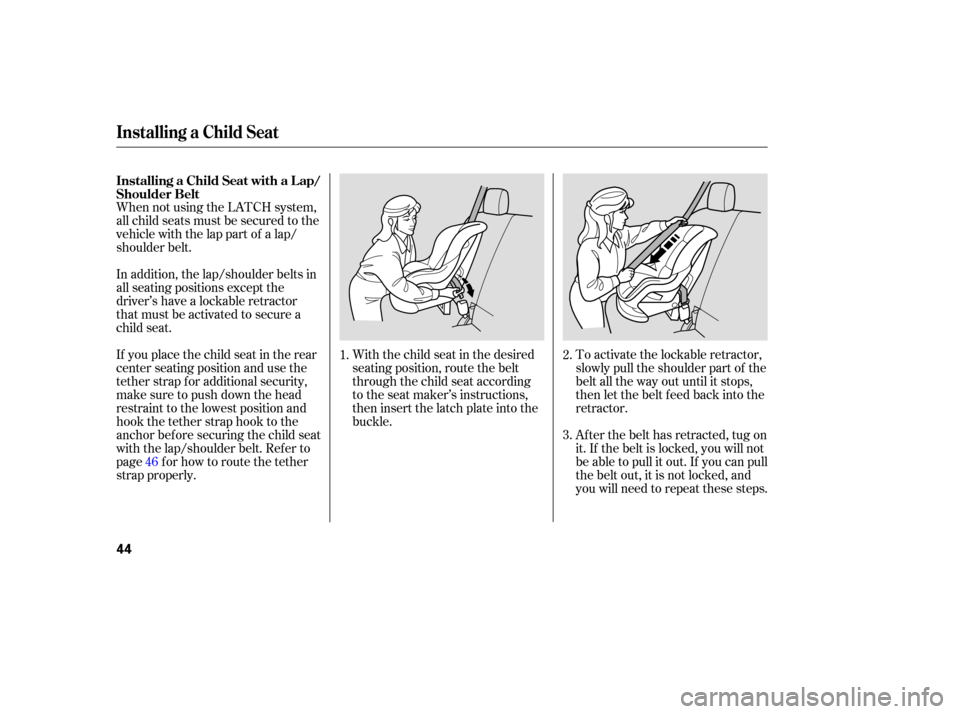Page 41 of 331

CONT INUED
An inf ant must be properly
restrained in a rear-f acing, reclining
child seat until the child reaches the
seat maker’s weight or height limit
f or the seat, and the child is at least
one year old.
Only a rear-f acing child seat provides
proper support f or a baby’s head,
neck, and back.Two types of seats may be used: a
seat designed exclusively f or inf ants,
or a convertible seat used in the rear-
f acing, reclining mode.
If placed
f acing f orward, an inf ant could be
very seriously injured during a
f rontal collision. A rear-f acing child seat can be placed
in any seating position in the back
seat, but not in the f ront.
If the passenger’s front airbag
inflates, it can hit the back of the
child seat with enough f orce to kill or
seriously injure an inf ant.
When properly installed, a rear-
f acing child seat may prevent the
driver or a f ront passenger f rom
moving their seat as far back as
recommended, or f rom locking their
seat-back in the desired position.
It can also interf ere with proper
operation of the passenger’s
advanced front airbag system.
Protecting Inf ants
Child Seat T ype
Do not put a rear-f acing child seat in
a f orward-f acing position. Never put a
rear-f acing child seat in t he f ront seat .
Child Seat Placement
Protecting Inf ants and Small Children
Driver and Passenger Saf ety
37
Page 48 of 331

When not using the LATCH system,
all child seats must be secured to the
vehicle with the lap part of a lap/
shoulder belt.
With the child seat in the desired
seating position, route the belt
th rough the child seat according
to the seat maker’s instructions,
then insert the latch plate into the
buckl e. To
activate the lockable retractor,
slowly pull the shoulder part of the
belt all the way out until it stops,
th en let the belt feed back into the
retractor.
After the belt has retracted, tug on
it. If the belt is locked, you will not
be able to pull it out. If you can pull
thebeltout,itisnotlocked,and
you will need to repeat these steps.
In
addition, the lap/shoulder belts in
all seating positions except the
driver’s have a lockable retractor
that must be activated to secure a
child seat.
If you place the child seat in the rear
center seating position and use the
tether strap for additional security,
make sure to push down the head
restraint to the lowest position and
hook the tether strap hook to the
anchor bef ore securing the child seat
with the lap/shoulder belt. Refer to
page for how to route the tether
strap properly. 1.
2.
3.
46
Installing a Child Seat with a L ap/
Shoulder Belt
Installing a Child Seat
44
Page 49 of 331
Af ter conf irming that the belt is
locked, grab the shoulder part of
the belt near the buckle, and pull
up to remove any slack from the
lap part of the belt. Remember, if
the lap part of the belt is not tight,
the child seat will not be secure.Push and pull the child seat
f orward and f rom side-to-side to
verify that it is secure enough to
stay upright during normal driving
maneuvers. If the child seat is not
secure, unlatch the belt, allow it to
retract f ully, then repeat these
steps.
To remove slack, it may help to
putweightonthechildseat,or
push on the back of the seat while
pulling up on the belt. To deactivate the lockable retractor
and remove a child seat, unlatch the
buckle, unroute the seat belt, and let
the belt fully retract.
4. 5.
Installing a Child Seat
Driver and Passenger Saf ety
45
Page 61 of 331

This section gives inf ormation about
the controls and displays that
contribute to the daily operation of
your vehicle. All the essential
controls are within easy reach............................
Control Locations .58
............................
Instrument Panel .59
..........
Instrument Panel Indicators .61
.............................................
Gauges .70
Controls Near the Steering
...........................................
Wheel .74
........................
Multi-Control Lever .75
...................
Headlight Control Dial .76
........
Instrument Panel Brightness .78
.................
Hazard Warning Button .79
..........
Steering Wheel Adjustment .79
..................................................
Keys .80
........................
Immobilizer System .81
................................
Ignition Switch .82
......................................
Door Locks .83
.......................
Remote Transmitter .89
.......................
Dual-Action Tailgate .92
...............................
In-Bed Trunk .95
.................................................
Seats .98
..................................
Seat Heaters .104
............................
Power Windows .105
.......................................
Moonroof .108
...............................
Parking Brake .109
...........................................
Mirrors .110 .........
Interior Convenience Items .112
.........................
Center Console .113
.......
Console Compartments .113
.........................
Cargo Hooks .114
.....................
Beverage Holders .114
..................................
Glove Box .115
................................
Coat Hooks .115
....................
Sunglasses Holder .115
........
Accessory Power Sockets .116
...................................
Sun Visor .117
............................
Vanity Mirror .117
...............................
Interior Lights .118
.....................................
Bed Lights .120
Instruments and Controls
Inst rument s and Cont rols
57
TM
Page 62 of 331
�Î
�Î
�Î
Ifequipped
Control
Locations
58
HOOD RELEASE
HANDLE
PARKING BRAKE
PEDAL GLOVE
BOX
AUDIO
SYSTEM
POWER WINDOW
SWITCHES INSTRUMENT
PANEL INDICATORS
GAUGES
HEATING/COOLING
CONTROLS
CENTER CONSOLE
POWER
DOOR LOCK
MASTER SWITCH
MIRROR
CONTROLS
Vehicle with navigation system is shown. CLIMATE
CONTROL
SYSTEM
ACCESSORY POWER SOCKETS
PARKING
BRAKE
RELEASE HANDLE
FUEL FILL DOOR
RELEASE HANDLE AUXILIARY
INPUT
JACK
REAR
VIEW MIRROR WITH
COMPASS
(P.59)
(P.70)
(P.109)
(P.111)
(P.83)
(P.105)
(P.109) (P.113) (P.116)(P.115)
(P.128)
(P.122)
(P.161)
(P.133)
(P.168)
(P.179)
(P.181)
Page 63 of 331
Instrument Panel
Instru me ntsand Cont ro ls
U.S. models
59
IMMOBILIZER SYSTEM
INDICATOR
WASHER LEVEL
INDICATOR
MALFUNCTION INDICATOR
LAMP LOW OIL PRESSURE
INDICATOR VSA ACTIVATION INDICATOR
VTM-4 INDICATOR
HIGH BEAM INDICATOR
A/T TEMPERATURE INDICATOR
LIGHTS ON INDICATOR
TPMS INDICATOR
CHARGING SYSTEM
INDICATOR
PARKING BRAKE AND
BRAKE SYSTEM
INDICATOR SIDE
AIRBAG OFF
INDICATOR
LOW FUEL INDICATOR
CRUISE CONTROL INDICATOR
BACK WINDOW OPEN
INDICATOR LOW
TIRE PRESSURE
INDICATOR MAINTENANCE
MINDER
INDICATOR
ANTI-LOCK BRAKE SYSTEM
INDICATOR
VEHICLE
STABILITY
ASSIST (VSA) SYSTEM
INDICATOR
SUPPLEMENTAL
RESTRAINT
SYSTEM
INDICATOR
SEAT BELT
REMINDER
INDICATOR
BED LIGHTS ON INDICATOR
IN-BED
TRUNK OPEN
INDICATOR (P.67)
(P.66)
(P.66)
(P.66)
(P.68)
(P.69)
(P.62)
(P.63) (P.62)
(P.62)
(P.69) (P.67)
(P.68) (P.67)
(P.62) (P.63)
(P.65)
(P.62)
(P.61)
(P.65)
(P.65)
(P.63)
(P.69) (P.64)
(P.65)
DOOR AND TAILGATE
OPEN MONITOR
TIRE PRESSURE MONITOR
(P.68)
Page 64 of 331
Instrument Panel
Canadian models
60
IMMOBILIZER SYSTEM
INDICATOR
WASHER LEVEL
INDICATOR
MALFUNCTION INDICATOR
LAMP LOW OIL PRESSURE
INDICATOR
VSA
ACTIVATION INDICATOR
VTM-4 INDICATOR
HIGH BEAM INDICATOR
A/T TEMPERATURE INDICATOR
LIGHTS ON INDICATOR
TPMS INDICATOR
CHARGING SYSTEM
INDICATOR
PARKING BRAKE AND
BRAKE SYSTEM
INDICATOR SIDE
AIRBAG OFF
INDICATOR
LOW FUEL INDICATOR
CRUISE CONTROL INDICATOR
BACK WINDOW OPEN
INDICATOR LOW
TIRE PRESSURE
INDICATOR MAINTENANCE
MINDER
INDICATOR
ANTI-LOCK BRAKE SYSTEM
INDICATOR
VEHICLE
STABILITY
ASSIST (VSA) SYSTEM
INDICATOR
SUPPLEMENTAL
RESTRAINT
SYSTEM
INDICATOR
SEAT BELT
REMINDER
INDICATOR
DAY
TIME RUNNING LIGHTS
INDICATOR
BED LIGHTS ON INDICATOR
IN-BED
TRUNK OPEN
INDICATOR (P.67)
(P.66)
(P.66)
(P.65) (P.66)
(P.68) (P.69)
(P.62)
(P.63) (P.62)
(P.62)
(P.69) (P.64)
(P.69)
(P.67)
(P.68) (P.67)
(P.62) (P.63)
(P.65)
(P.62)
(P.61)
(P.65)
(P.65)
(P.63)
(P.65)
DOOR AND TAILGATE
OPEN MONITOR
TIRE PRESSURE MONITOR
(P.68)
Page 67 of 331

This indicator has two functions:
This indicator also blinks several
times when you turn the ignition
switch from the ON (II) position to
the ACCESSORY (I) or LOCK (0)
position.
If it stays on after you have fully
released the parking brake while
the engine is running, or if it
comes on while driving, there
could be a problem with the brake
system. For more information, see
page . This indicator normally comes on for
a few seconds when you turn the
ignition switch to the ON (II)
position, and when the ignition
switch is turned to the START (III)
position. If it comes on at any other
time, there is a problem with the
ABS. If this happens, have your
ve
hicle checked at a dealer. With the
indicator on, your vehicle still has
norm al braking ability but no anti-
lock brakes. For more info rmation,
see page . This indicator comes on for a few
seconds wh
en you turn the ignition
switch to the ON (II) position. It will
gooffifyouhaveinserteda
properly-coded ignition key. If it is
not a properly-coded key, the
indicator will blink and the engine
will not start (see page ).
Itcomesonwhenyouturnthe
ignition switch to the ON (II)
position. It is a reminder to check
the parking brake. A beeper
sounds if you drive with the
parking b
rake not fully released.
Driving with the parking brake not
fully released can damage the
brakes and tires.
1.
2. 81
290 208
Anti-lock Brake System
(A BS) Indicator
Immobilizer System
Indicator
Parking Brake
and Brake
System
Indicator
Instrument Panel Indicators
Inst rument s and Cont rols
63
U.S. Canada